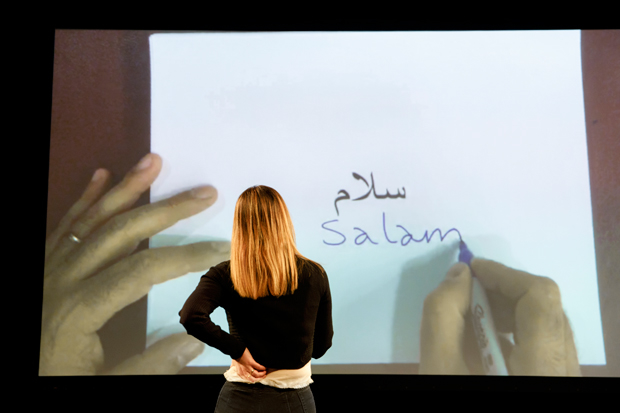Nassim Soleimanpour Enacts a Cultural Exchange in Nassim

(© Joan Marcus)
Nassim could be described as "experimental," but whereas that term suggests something potentially obscure and forbidding, Nassim Soleimanpour's new theater piece, making its American premiere at New York City Center Stage II, is the polar opposite: warm and inviting. That's appropriate for a show that is, in part, a cultural exchange, in which the Iranian playwright — who, unlike in his previous piece White Rabbit Red Rabbit, actually appears onstage, turning the pages of his own script — tries to connect with foreign audiences while also giving us a sense of his own life and upbringing in his home country of Iran.
The experimental aspects of Nassim will be familiar to those who've seen White Rabbit Red Rabbit. As with that earlier play, each performance features a guest actor who reads, under Omar Elerian's direction, Soleimanpour's 400-page script for the very first time. The text is also projected on a screen toward the back of Rhys Jarman's minimalist set design. To some degree, how a particular performance of Nassim plays out depends on how game the guest actor is in handling the text and following the playwright's written instructions. Thankfully, John-Michael Lyles (seen most recently in This Ain't No Disco), the guest actor at the performance I attended, was an enthusiastic participant. Lyles's boyish eagerness also seemed to feed into Soleimanpour's own off- and onstage performance, encouraging the mostly silent performer-playwright to go for broad, Chaplinesque facial expressions that might have seemed too exaggerated next to a more reserved guest actor.
Audience participation is also a considerable part of Nassim, for better and for worse. Turning the stage into a classroom for a Farsi lesson, as Soleimanpour does at one point, is, however baldly didactic, fitting in the context of the piece's spirit of inclusiveness, especially as he beckons us to teach him some English words in return. Still, opening the floor up to audience members at another point during the show to give donations, monetary or otherwise, to Soleimanpour as a way of welcoming him to the city is surely a bridge too far (if only other playwrights were half as clever in the ways they begged for money and objects while trying to hide behind the guise of "art"). That lapse in taste notwithstanding, most of the audience-participation gambits — including a game in which three volunteers try to remember Farsi phrases and recite them in a particular order — are in keeping with the creator's broader aim to foster a dialogue between two different languages and cultures.
It's that ultimate goal, thematically woven together at the end of the 80-minute production, that gives Nassim a poignancy that goes beyond the pleasantly playful surface. Soleimanpour depicts himself as a naïf who uses this cultural exchange not only as a way to stave off his own homesickness, but to suggest the possibility of language as being a unifying rather than a dividing force. It's possible to find Soleimanpour's idealism overly sentimental, an impression reinforced by the creator's own performance, at times too insistent in trying to evoke childlike pathos. Still, maybe a dash of utopianism, especially one as sincerely articulated as in Nassim, has its place in a time as dispiritingly divisive as the one we're in right now.

(© Joan Marcus)










